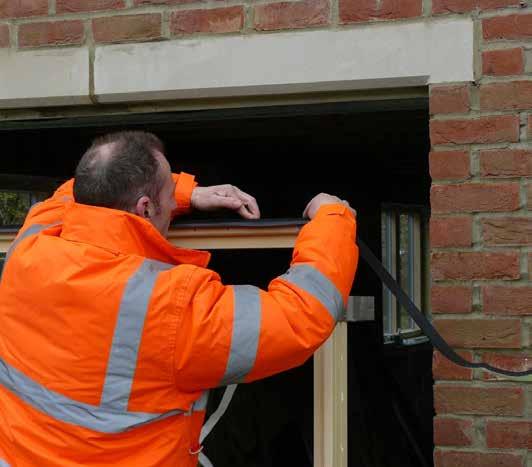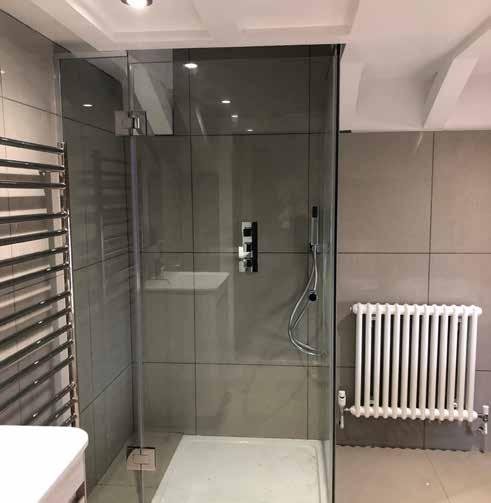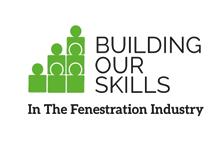
8 minute read
Installer Focus
FIRESIDE CHAT NO. 1: COLOUR AND INNOVATION
Freefoam Building Products are pleased to announce the launch of a new informative and interesting video focussing on colour roofline and product innovation.
As part of a series of informal and topical video discussions we are calling ‘Fireside Chats’, Freefoam Commercial Director Colin St John explains in this first video the trend for colour fascia, soffit and rainwater products, Freefoam’s
approach to product innovation and how both aspects give Freefoam customers more choice and more opportunities.
Colin has worked at Freefoam for around 20 years and been in the pvc building products industry for 32 years so his expertise and knowledge gives a great insight into the changes and developments taking place and their implications for the future. This video will be the first of several to be released this Autumn. Other topics covered will include the Freefoam approach to supply of housebuilders, the supply chain and challenges it faces and Freefoam’s approach to supporting and helping customers grow.
View video about colour and innovation here: https://www.youtube.com/watch?v=FSZd7-fPllo
VIDEO LINK
INSTALLER FOCUS The UK’s Leading Glass & Glazing Newspaper A DIFFERENT KIND OF CRISIS
With demand outstripping supply, companies are feeling the heat. Here, Purplex MD Andrew Scott discusses how installers can turn consumer demand into more profitable business – and how now is the ideal time to re-evaluate.
Demand is what we all crave when it comes to running a business in any industry. So, it appears strange to be talking of rising demand as a crisis in the glass and glazing industry – but that’s what’s happening. The industry could be forgiven for thinking it’s just bouncing from one crisis to the next. Having seen sales and margins impacted by the referendum, Brexit and a general election, doors had to then close completely for three-four months due to Covid-19. Now it appears we are dealing with a different kind of crisis, with demand outstripping supply. Companies large and small are feeling the pressure as lead-times are extended, service levels drop and prices going up. Nobody could have predicted the current situation and manufacturers and suppliers across the industry are working hard to increase capacity and stock levels to meet customer demands. I had an interesting conversation with one of our long-term installer customers recently, which has grown rapidly over the last five years. The owner is stressed, as they are inundated with leads and orders, struggling with reliable suppliers, and having to deal with customers who are all demanding urgent fitting. As a sales-driven industry, we want the deal – to get the order or land the customer and figure out what to do afterwards. However, in the long-run, it means business owners are often on a treadmill that is difficult to step off. Given the individual circumstance of this installer, there are several strategies that would maximise profitability and sanity, both short-term and in the longer-term. Now is the ideal time to take a step back and re-evaluate your business from the ‘ground up’.
MINIMUM ORDER VALUE
Filling your order pipeline with single windows and doors at a time when your resources are stretched is uneconomical. Perhaps now is the time to apply a minimum order value (MOV), and here’s why: • They encourage customers to increase their orders to meet the minimal value (say from 2 windows to 4 windows). • If the customer doesn’t want to increase products and accepts the minimum order value it improves your profitability and ensures the job is more viable.
If the customer chooses not to go ahead with you, it means your team are freed up to manage the larger and more profitable orders in your pipeline.
MOV’s can be adjusted up or down depending on your current lead flow and order pipelines.
REVIEW YOUR CONTRACT AND WARRANTIES
Our industry’s approach to long-term guarantees adds huge costs further down the line and sucks up precision fitting/ labour time. Now is the time to review your customer contracts, including guarantees. extended warranty as an optional extra? And if you did change your warranties what impact would it have in five-10-years’ time? This is obviously a longer-term play, but it is an issue the industry should have addressed years ago.
PRIORITISE MARKETING SPEND
Right now, chances are you have a strong lead flow, but that doesn’t mean it’s time to cut your marketing spend. In fact, it’s the time to prioritise your marketing activity. For example, if installation is the biggest headache right now, prioritise marketing to focus on products that are high value but quick-fits – such as replacement conservatory roofs or bi-fold doors. That way, you maximise profitability on a per-fitting team basis. Or why not use this opportunity to build your order pipeline? Given that most of your competitors are also busy, extending lead times now will give you a safety net when demand starts to slow. Indeed, there is an argument for maximising your marketing activity right now, capturing maximum business and deferring installation.
BE PROACTIVE NOW
While the market continues to be strong, with consumer spending and the property market remaining robust, I suspect it will soon be time to ‘pay the ferryman’. The financial cost of Covid-19 and the lockdown leaves an eye-watering deficit that must be addressed. At the time of writing, the Chancellor was reviewing £30bn in post-Covid tax hikes, and Corporation Tax rates and Entrepreneurs Relief (Business Asset Disposal Relief) are on the agenda. So, taking the right steps now to review your business and marketing strategy will help prepare your business for an uncertain future. Andrew Scott is a leading industry consultant who has acquired, built, and sold several successful companies in the industry, including manufacturers, distributors, and retail businesses. He is the founder and MD of Purplex Marketing and Insight Data. For more information visit www.purplexmarketing.com.
INSTALLERS: FILLING THE GAP POST COVID-19
Andy Swift, sales & operations manager - UK & ROI at ISO Chemie, considers how foam sealants can help installers and home improvement specialists secure the perfect finish for doors and windows.
It’s likely that homeowners, who have been thinking about their properties during the current crisis, will take the opportunity to invest in their properties, which will include moves to improve exterior appearances, as lockdown measures continue to ease in the coming months. This will carve out increased opportunity for foam tapes as alternatives to silicone sealants for the effective sealing of joints around the windows and doors, where widths can vary in size and installers can never be certain what they will face when they arrive on site. While there have been advances in glass and window frame technology in recent years, it could also be argued that too many applications - and customers - are being let down by poor installations. Indeed, it could be added that in the light of product innovation, that it’s perhaps ‘criminal’ that a
“There’s no question companies in the fenestration sector can still do more to improve overall energy efficiency and sealing tapes are one effective way that this can be achieved. These multipurpose tapes enable installers and home improvement specialists to quickly and easily seal windows from inside the building during construction, avoiding the need for expensive access systems and delivering cost savings that can be passed on to consumers along with high quality installations.”


lamentable number of installations remain unchecked or unregulated; leaving behind a legacy of problems that could last for years and cost thousands of pounds to rectify in the long run. Heat will always find the fastest exit as it comes up against the ‘A’ or ‘A+’ rated window and this is invariably the 10mm or so expansion gap left around the window when it was originally fitted. This is normally left empty, but some uncontrolled volume of spray foam can be injected to fill the void before a silicone trim is applied for a smart looking finish. Unfortunately, as expedient as this might be, none of these solutions create a measurable, long term, high performance thermal, acoustic or airtight barrier: The U-Value of the installed window is simply reduced, which leads to heat escape and ultimately, financial loss. If building regulations remain lenient, we will continue to see window and door developments that only just meet minimum standards. But installers deserve better insulating products to improve energy efficiency and save money for their endusers, and the latest generation of high performance foam sealing tapes, which use ‘smart’ foams impregnated with different substances to create a measurable U-Value as low as 0.6w/m2k, offer superb thermal insulation and acoustic sound reduction by 44dB. As these installation tapes are completely weather resistant against driving rain, even to Violent Storm Force 11 wind speeds, installers can quickly apply them around the frame during initial fitting. This provides the assurance that they have completed a comprehensive ‘A’ rated installation rather than just supplying an ‘A’ rated window. This is a benefit that can be sold on to deliver enhanced energy efficiency advantages for customers and property owners. There’s no question companies in the fenestration sector can still do more to improve overall energy efficiency and sealing tapes are one effective way

that this can be achieved. These multipurpose tapes enable installers and home improvement specialists to quickly and easily seal windows from inside the building during construction, avoiding the need for expensive access systems and delivering cost savings that can be passed on to consumers along with high quality installations. Moreover, because the foam sealant can be used in the wet, window installations can be undertaken regardless of external weather conditions, avoiding time consuming and costly delays. While it’s clear that the coming months will be challenging, window and door installers can look ahead with much optimism. Markets will inevitably return, creating strong competition for business. Armed with good quality products such as sealant tapes, installers will be able to add value, protect margins and assure customers that energy efficiency is at least as good as the window. This way, installers can be seen to earnestly and genuinely improve the way they safeguard customers and the industry’s reputation.










